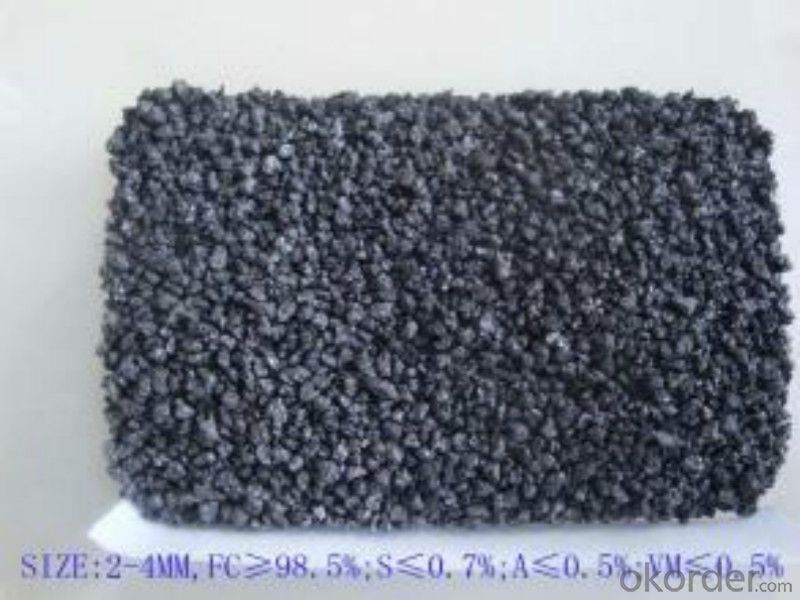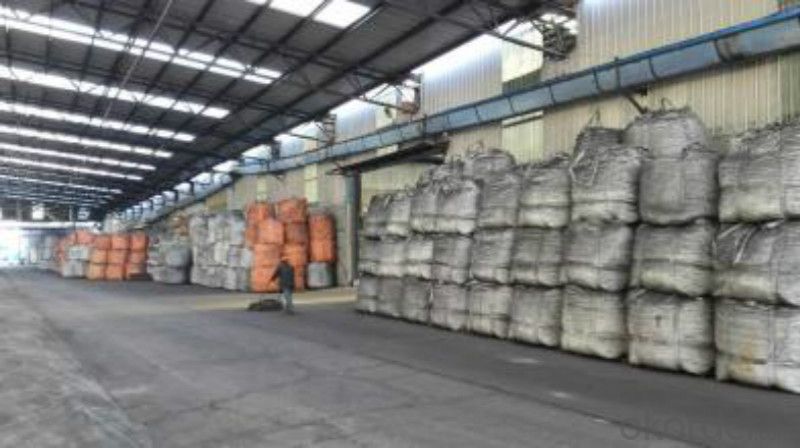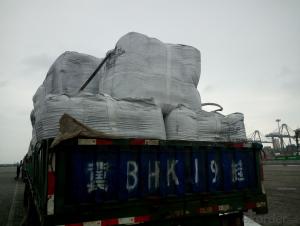Calcined Pitch Coke with Ash 0.5 percent max as carbon additive
- Loading Port:
- Tianjin
- Payment Terms:
- TT OR LC
- Min Order Qty:
- 21 m.t.
- Supply Capability:
- 8000 m.t./month
OKorder Service Pledge
OKorder Financial Service
You Might Also Like
Introduction
Pitch Coke/Coal Tar Pitch is a kind of black brittleness and blocky piece, lustrously at normal temperature. It has special odour and poisonous and can be easily flame when melting, second-grade inflammable solid.
Pitch Coke/Coal Tar Pitch is obtained from powerfully processed coal tar. Compared to petroleum asphalt, the adhesiveness is better. Coal Tar Pitch is high quality tar production with high fixed carbon. It has excellent adhesion, waterproofing and resistance against seawater, oil and various chemicals. In these properties, it is much better than petroleum asphalt tar.
It can be used to produce painting, electrode, pitch coke, and tar felt. It also can be used as fuel and the raw material of asphalt carbon black.
Features:
The morphology, chemistry and crystallinity of recarburisers have a major impact on the overall casting cost. The combined application and cost benefits, which are derived through the use of Desulco, enable foundries to manufacture castings in a highly cost effective manner.
reduces
Recarburiser consumption
Power consumption
Inoculant consumption
MgFeSi consumption
Furnace refractory wear
Scrap rate
Tap to tap time
Slag inclusions risk
Chill
increases
Casting microstructure
Productivity
Process consistency
Carbon Recovery
Compared with calcined petroleum coke, acetylene coke and
graphite electrode scrap, Desulco yields the highest carbon
recovery and fastest dissolution time
Specifications:
CPC | |||
F.C.% | 98.5MIN | 98.5MIN | 98MIN |
ASH % | 0.8MAX | 0.8MAX | 1MAX |
V.M.% | 0.7 MAX | 0.7 MAX | 1 MAX |
SULFUR % | 0. 5MAX | 0. 7MAX | 1MAX |
MOISTURE % | 0.5MAX | 0.5MAX | 1MAX |
Pictures:




FAQ:
1.MOQ:2 Containers |
2.Size:1-3mm,1-5mm,2-6mm,3-5mm and as the customer's requirement |
3.Packing: 1 ton jumbo bag or 25kgs paper in bag |
4.Payment:T/T or L/C at sight |
5.Delivery time: within 15 days after receiving the deposit |
6.Usage: it is as carbon raiser,widely used in steelmaking,casting,casting iron,steel foundry,aluminum metallury. |
- Q:How does carbon impact the global water cycle?
- Carbon can have a significant impact on the global water cycle through various processes. One major way carbon affects the water cycle is through the process of photosynthesis. Plants and trees take in carbon dioxide from the atmosphere during photosynthesis and convert it into oxygen and glucose. This process not only helps in the carbon cycle but also plays a crucial role in the water cycle. During photosynthesis, plants release water vapor into the atmosphere through tiny pores called stomata. This water vapor contributes to the overall humidity in the atmosphere, leading to an increase in cloud formation. Clouds, in turn, play a crucial role in the water cycle as they contain condensed water droplets that eventually fall as precipitation. Additionally, carbon dioxide is a greenhouse gas that contributes to global warming and climate change. As the Earth's temperature rises due to increased levels of carbon dioxide, the water cycle is also affected. Warmer temperatures can lead to increased evaporation rates, causing more water to evaporate from oceans, rivers, and lakes. This excess moisture in the atmosphere can result in more intense rainfall events, leading to floods and other extreme weather events. Furthermore, carbon dioxide can impact the acidity of water bodies. When carbon dioxide dissolves in water, it forms carbonic acid, which can lower the pH of the water. This process, known as ocean acidification, can have detrimental effects on marine life, particularly organisms that rely on calcium carbonate for their shells and skeletons. These impacts can disrupt the balance of ecosystems and have long-term consequences for the health and functioning of the global water cycle. In summary, carbon has a profound impact on the global water cycle through processes such as photosynthesis, greenhouse gas emissions, and ocean acidification. Understanding these interactions is crucial for managing the effects of carbon on the environment and ensuring the sustainability of the water cycle.
- Q:How does carbon occur in nature?
- Carbon occurs in nature in various forms and is one of the most abundant elements on Earth. It is found in the atmosphere, in the Earth's crust, and in living organisms. In the atmosphere, carbon exists primarily as carbon dioxide (CO2), which is produced through natural processes such as respiration, volcanic activity, and the decay of organic matter. This CO2 is then absorbed by plants during photosynthesis to produce energy and release oxygen. Carbon is also present in other greenhouse gases like methane (CH4), which is produced by natural processes such as the decomposition of organic matter in wetlands and the digestive processes of certain animals. In the Earth's crust, carbon is found in various minerals such as limestone, dolomite, and graphite. These minerals are formed through the deposition and accumulation of marine organisms, such as shells and skeletons of marine organisms, over millions of years. Carbon is also a key component of fossil fuels, including coal, oil, and natural gas, which are formed from the remains of ancient plants and animals buried and subjected to high pressure and temperature over time. Furthermore, carbon is an essential element for all living organisms and is the basis of organic chemistry. It is the key component of all organic matter, including carbohydrates, proteins, lipids, and nucleic acids, which form the building blocks of life. Carbon cycles through various biological processes, such as photosynthesis, respiration, and decomposition, allowing it to be continually recycled within ecosystems. Overall, carbon occurs naturally in the environment in different forms and plays a crucial role in the Earth's climate system, geological processes, and the sustenance of life.
- Q:How long will it last? 10National Day would like to do carbon baking ribs at home, how to do, how to marinate? For how long?.. Don't copy sticky posts. Now, tour TV's "eating meat" on earth is recorded in a grilled pork chop, wondering how that is done
- Drain the spareribs until it is dryThis can save you a lot of timeMarinate it for only about fifteen minutes with gingerIf it's thawed, pour some white wineThen mix it with salt and drain the oilFinally, dressed with bamboo ribsWhen baking, brush some oil and turn it several times halfwayThen you can use barbecue sauce when it's readyIf you don't need barbecue sauce, then mix it with salt and monosodium glutamate, and brushFinally sprinkle five spice powder, chili powder and cumin powderFinally, sprinkle chopped green onionThe time is about 8 minutesHowever, oil, not prepared in advanceAt least 30 minutes
- Q:Is the power consumption of carbon fiber heating very high?
- Power consumption calculation:The information you give is not enough to calculate the approximate power consumption!You also need to know your building structure, insulation level, the laying power of electric heating, personal use, setting temperature, local temperature difference between indoor and outdoor, control device is intelligent temperature control and so on!There is also the first heating season, because the building is humid, the electricity consumption will be higher!How to save electric energyIf you want to save electricity, you need it:Give the building a good heat insulation,Use double or three layers of glass,Intelligent temperature controller, and according to the rules of personal life to set, make full use of energy saving, and these are not to reduce somatosensory comfort conditions,The carbon fiber heating cable laying and electric heating, far infrared ray to human body temperature will be higher, also need 18 degrees of comfort, the use of carbon fiber electric heating heating cable only need to set at 16 degrees, so the temperature can be, 2 DEG C, and the temperature difference is small at the only Province 2 C energy, in fact is not the case, as we all know, small temperature difference, the indoor temperature is more easy to maintain!Apply the peak and valley tariff to the local electricity department, so that the electricity price will be around 0.35 yuan at night, and the temperature will be greater at home and in the evening, which will save a lot of money!Do all of this and I'm sure you'll save 20% of your electricity bill!Poly Jiao carbon fiber heating cable electric heating - for you, we are more professional
- Q:How is carbon used in the production of filters?
- Carbon is commonly used in the production of filters due to its unique properties. One of the main uses of carbon in filters is its ability to adsorb, or attract and hold onto, impurities and contaminants. This is because carbon has a large surface area with many tiny pores, allowing it to effectively trap and remove particles, chemicals, and odors from air, water, and other substances. In air filters, carbon is often combined with other materials, such as activated charcoal, to create activated carbon filters. These filters are used to remove pollutants, allergens, and odors from the air. The activated carbon adsorbs the contaminants, trapping them within its porous structure and improving the overall air quality. In water filters, carbon can be used in different forms, such as granular activated carbon (GAC) or carbon block filters. GAC filters are commonly used in household water filtration systems and are effective in removing chlorine, volatile organic compounds (VOCs), pesticides, and other chemicals. Carbon block filters, on the other hand, are made by compressing activated carbon into a solid block, providing a higher surface area and better filtration efficiency. In addition to air and water filters, carbon is also used in various other types of filters, such as those used in industrial processes, gas masks, and respirators. The versatility of carbon in filtering applications is due to its ability to adsorb a wide range of contaminants and its high adsorption capacity. Its use in filters helps improve the quality and safety of the substances being filtered, making it an essential material in many filtration processes.
- Q:Excuse me, carbon steel, carbon steel pipe, seamless steel pipe, spiral steel pipe, what is the difference?
- There is no joint in the whole. The material can be used according to the needs, often used for high temperature, high pressure and other fluids. Hence, it is called seamless steel tube. The spiral steel tube is also formed by the heating and rotating of the strip steel. The utility model is suitable for the fluid below 30Kg, and the material can replace the seamless pipe with the big caliber and difficult to be manufactured according to the requirement, and is suitable for the medium and low pressure fluid with large caliber.
- Q:other parameters are figured out, the difference is only in the carbon and carbon is not very clear, just know that they are winding mode is the opposite, there are two kinds of most printers can be used, what is the difference between the performance of them? Two can use the printer in the selection of the best carbon or carbon? Why? Please cite several models as an example.Please answer in your own words. Don't factor,
- In fact, to teach you a simple way to distinguish between internal and external carbon, carbon, label paper dip ribbon, with black on the outside of the outer side is carbon, carbon is in inside, no performance difference, now generally used is the most carbon, such as the machine is to use carbon is better, because the wound is not the same, sometimes loose.SATO machine with carbon is better, and the CITIZEN printer inside and outside carbon can be used, in addition to machine limitations, not what the difference is too big, the quality of internal and external carbon ribbon is the same.
- Q:How does carbon impact the ozone layer?
- Carbon does not directly impact the ozone layer. However, carbon compounds such as chlorofluorocarbons (CFCs), which contain carbon, can have a significant impact on the ozone layer. When released into the atmosphere, CFCs can reach the stratosphere where they are broken down by ultraviolet (UV) radiation and release chlorine atoms. These chlorine atoms then catalytically destroy ozone molecules, leading to the depletion of the ozone layer. The destruction of the ozone layer is a critical environmental issue as it allows more harmful UV radiation from the sun to reach the Earth's surface. Increased UV radiation can have detrimental effects on human health, including skin cancer, cataracts, and weakened immune systems. It can also harm ecosystems by damaging phytoplankton, which are crucial for the marine food chain, and affecting the growth of plants and crops. To combat this problem, the international community has taken steps to reduce the production and use of ozone-depleting substances, including CFCs. The Montreal Protocol, an international environmental agreement, has been successful in phasing out the production of CFCs and other harmful substances. This has contributed to the recovery of the ozone layer, although it is still a long-term process. In conclusion, carbon itself does not directly impact the ozone layer. However, carbon compounds like CFCs, which are released into the atmosphere, can lead to the destruction of the ozone layer. Efforts to reduce the production and use of these ozone-depleting substances have been crucial in protecting the ozone layer and mitigating the harmful effects of increased UV radiation.
- Q:What are the advantages of carbon-based fuel cells?
- Carbon-based fuel cells offer several advantages that make them a promising technology for the future. Firstly, they have a higher energy density compared to conventional batteries, meaning they can store and deliver more energy per unit weight. This allows for longer operating times and greater power output, which is particularly beneficial in applications requiring high power density and long-range capabilities, like electric vehicles. Secondly, carbon-based fuel cells boast a faster refueling time than conventional batteries. While it can take hours to recharge a battery, refueling a carbon-based fuel cell can be done in a matter of minutes. This significant advantage reduces refueling downtime and enables more convenient and efficient usage of the technology. Furthermore, carbon-based fuel cells have a lower environmental impact compared to traditional combustion engines. They produce only water and heat as byproducts, making them clean and environmentally friendly. This is in contrast to internal combustion engines that emit harmful pollutants contributing to air pollution and climate change. Another advantage of carbon-based fuel cells is their versatility and compatibility with existing infrastructure. They can easily be integrated into current energy systems, facilitating a smooth transition from fossil fuels to cleaner energy sources. This compatibility makes carbon-based fuel cells a viable option for various applications, from portable electronics to residential power generation. Lastly, carbon-based fuel cells have the potential to contribute to energy independence. As carbon-based fuels can be derived from renewable sources like biomass or waste, they offer a sustainable and domestically sourced energy solution. This reduces dependence on foreign oil and enhances energy security for countries. In conclusion, the benefits of carbon-based fuel cells include higher energy density, faster refueling time, lower environmental impact, compatibility with existing infrastructure, and the potential for energy independence. With these advantages, carbon-based fuel cells have the potential to revolutionize the energy landscape and provide a sustainable and efficient alternative to conventional energy sources.
- Q:Will long-term use of carbon alloy chopsticks cause cancer?
- The chopsticks are washed with water for a long time, and the water content is especially high. The chopsticks are placed in the non ventilated place for a long time, and the chances of deterioration of the chopsticks are improved." Huang Yahui said, especially the moldy chopsticks, may be contaminated by aflatoxin. It is understood that aflatoxin is the 1 class of carcinogens, is a highly toxic highly toxic substances, human and animal liver tissue will have a damaging effect, can lead to serious liver cancer or even death. Huang Yahui warned that the public should be weekly chopsticks into boiling water after half an hour, placed in the air to air dry before use, it can achieve the disinfection effect, and can effectively and conveniently remove mildew in chopsticks. In addition, it is best to use half a year to replace the new chopsticks, so you don't have to worry too much. "The selection of chopsticks is also very exquisite."." Huang Yahui said, "the ideal chopsticks are bamboo chopsticks and non staining wooden chopsticks.". After the dyed or painted wood, paint and stain will enter the body with food. When in use, especially the stain in heavy metals, benzene and other harmful substances, can cause gastrointestinal inflammation, ulceration, erosion, serious can cause cancer.
1. Manufacturer Overview |
|
|---|---|
| Location | |
| Year Established | |
| Annual Output Value | |
| Main Markets | |
| Company Certifications | |
2. Manufacturer Certificates |
|
|---|---|
| a) Certification Name | |
| Range | |
| Reference | |
| Validity Period | |
3. Manufacturer Capability |
|
|---|---|
| a)Trade Capacity | |
| Nearest Port | |
| Export Percentage | |
| No.of Employees in Trade Department | |
| Language Spoken: | |
| b)Factory Information | |
| Factory Size: | |
| No. of Production Lines | |
| Contract Manufacturing | |
| Product Price Range | |
Send your message to us
Calcined Pitch Coke with Ash 0.5 percent max as carbon additive
- Loading Port:
- Tianjin
- Payment Terms:
- TT OR LC
- Min Order Qty:
- 21 m.t.
- Supply Capability:
- 8000 m.t./month
OKorder Service Pledge
OKorder Financial Service
Similar products
New products
Hot products





























